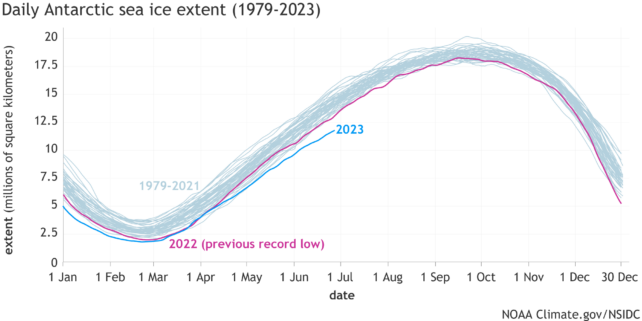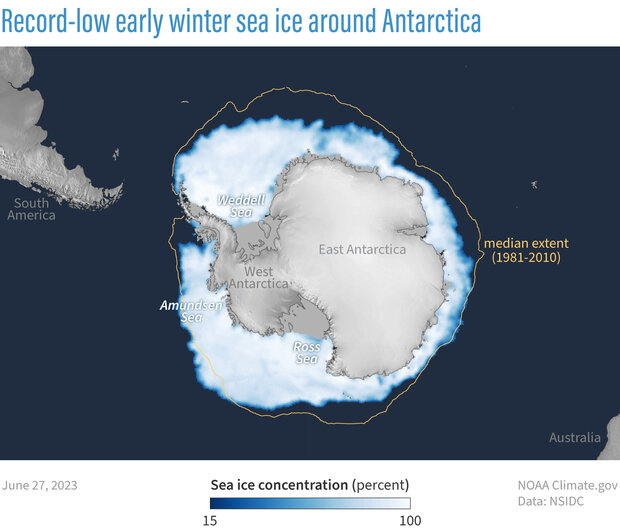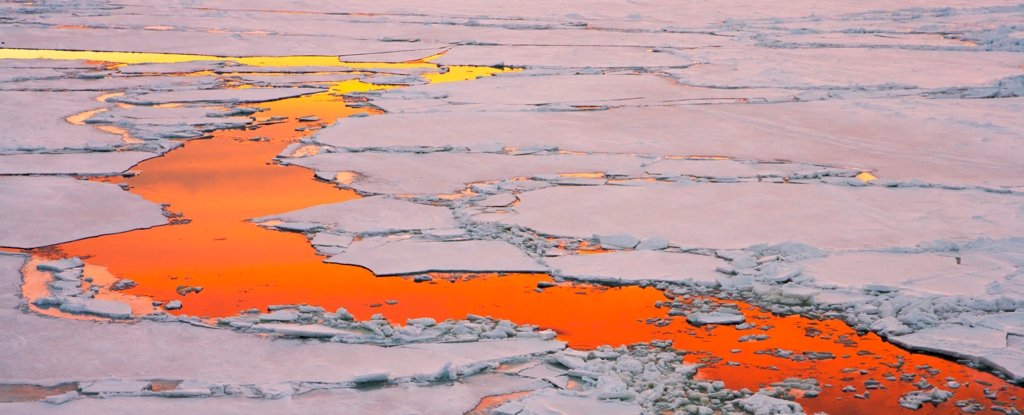Products You May Like
2023 has gone from bad to worse for Earth’s southern ocean.
In February, climate researchers announced that Antarctica’s sea ice had hit its lowest summer level since satellite records began 45 years ago.
A few months later, in June, during what should be a ‘winter growth phase‘, floating sea ice around Antarctica was still struggling to recover.
A time series of sea ice in the southern ocean, put together by climate researchers at the US National Oceanic and Atmospheric Administration, shows July’s coverage is well below where it should be.
Compared to the extent of winter sea ice before 2010, the ocean is now missing about 2.6 million square kilometers of ice – almost four times the size of Texas.

The new extreme beats previous record lows reached in 2016, 2017, and 2022.
“To say unprecedented isn’t strong enough,” physical oceanographer Edward Doddridge told ABC News Australia.
At the time the record low had reached the level of a five-sigma event, the threshold at which researchers are really confident that what they’re seeing isn’t just the random variability from the Universe’s chaos at work.
“For those of you who are interested in statistics, this is a five-sigma event,” explained Doddridge.
“So it’s five standard deviations beyond the mean. Which means that if nothing had changed, we’d expect to see a winter like this about once every 7.5 million years.”
It has since reached 6.4 standard deviations away from the 1991 to 2020 mean.
Apologies in advance for not explaining this in any way, but here are the daily standard deviations for Antarctic sea ice extent for every day, 1989-2023, based on the 1991-2020 mean. Each blue line represents the SD’s for a full year. Lighter is more recent.
2023 is in red. pic.twitter.com/C4lLug9mlL
— Prof. Eliot Jacobson (@EliotJacobson) July 24, 2023
Doddridge says the climate crisis is most likely to blame, although how it is driving such extreme sea ice melt remains unclear.
For years now, Antarctica’s ice has been melting in a way that climate models never predicted.
The mismatch makes it clear that scientists do not yet have a detailed understanding of how the southern hemisphere’s ocean, ice, and atmosphere actually interact.

As the global temperature of the atmosphere has warmed from fossil fuel emissions, evidence suggests the surface of the southern ocean has somewhat cooled, while deeper parts have warmed.
Cooler surface water might sound like a hopeful condition for floating sea ice, but after years of a steady increase in ice coverage, Antarctica’s sea ice suddenly collapsed in 2016.
Why this happened so abruptly is something that climate scientists are desperately trying to figure out.
Initial studies suggest that increasingly warm winds in the region might be driving the melt.
Our transition into an El Niño has created particularly stormy westerly winds across the Southern Ocean over the last few months.
This likely broke up a lot of the new sea ice that usually forms as winter sets in. But it can’t fully account for the magnitude of missing sea ice, Princeton University climate scientist Zachary Labe explains in a blog post.
Upwelling of warm waters could also be eating away at the icebergs from underneath.
Labe suggests the lack of ice also helped increase surface air temperatures, which in turn likely warmed surface waters to create a positive feedback loop further preventing ice formation.
If enough sea ice melts around Antarctica, scientists fear it could set off further positive feedback loops, as waves and warm wind more easily reach the shore.
“It’s not just the extent of the ice, but also the duration of the coverage,” cryospheric scientist Rob Massom, of the Australian Antarctic Division, explained to The Guardian.
“If the sea ice is removed, you expose floating ice margins to waves that can flex them and increase the probability of those ice shelves calving. That then allows more grounded ice into the ocean.”
Without more research, scientists are simply unable to predict what will become of the southern ocean’s sea ice in the years to come.
As the southern ocean helps drive Earth’s entire ocean circulation, it seems like something we should get on top of, fast.
“It may be that next winter it comes back,” Doddridge told the ABC.
“We can hope. I don’t know that it will.”
